Comparative Analysis: Employee Relations in Australia and India
VerifiedAdded on 2022/11/07
|8
|2675
|331
Essay
AI Summary
This essay provides a comparative analysis of employee relations in Australia and India, examining the key actors involved, including the state, trade unions, and employers. The essay explores the influence of government policies, labor laws, and trade unions on the employment landscape of both countries. It highlights the differences in the legal frameworks, economic conditions, and the roles of various stakeholders in shaping employment relations. The essay discusses the functions of trade unions, the responsibilities of employers, and the impact of jurisdictional factors. It concludes by comparing the efficiency and organization of employment actors in Australia versus India, considering their respective economic development levels and the challenges they face. The analysis provides insights into the dynamics of employment relations and suggests strategies for maintaining effective relationships among the parties involved.
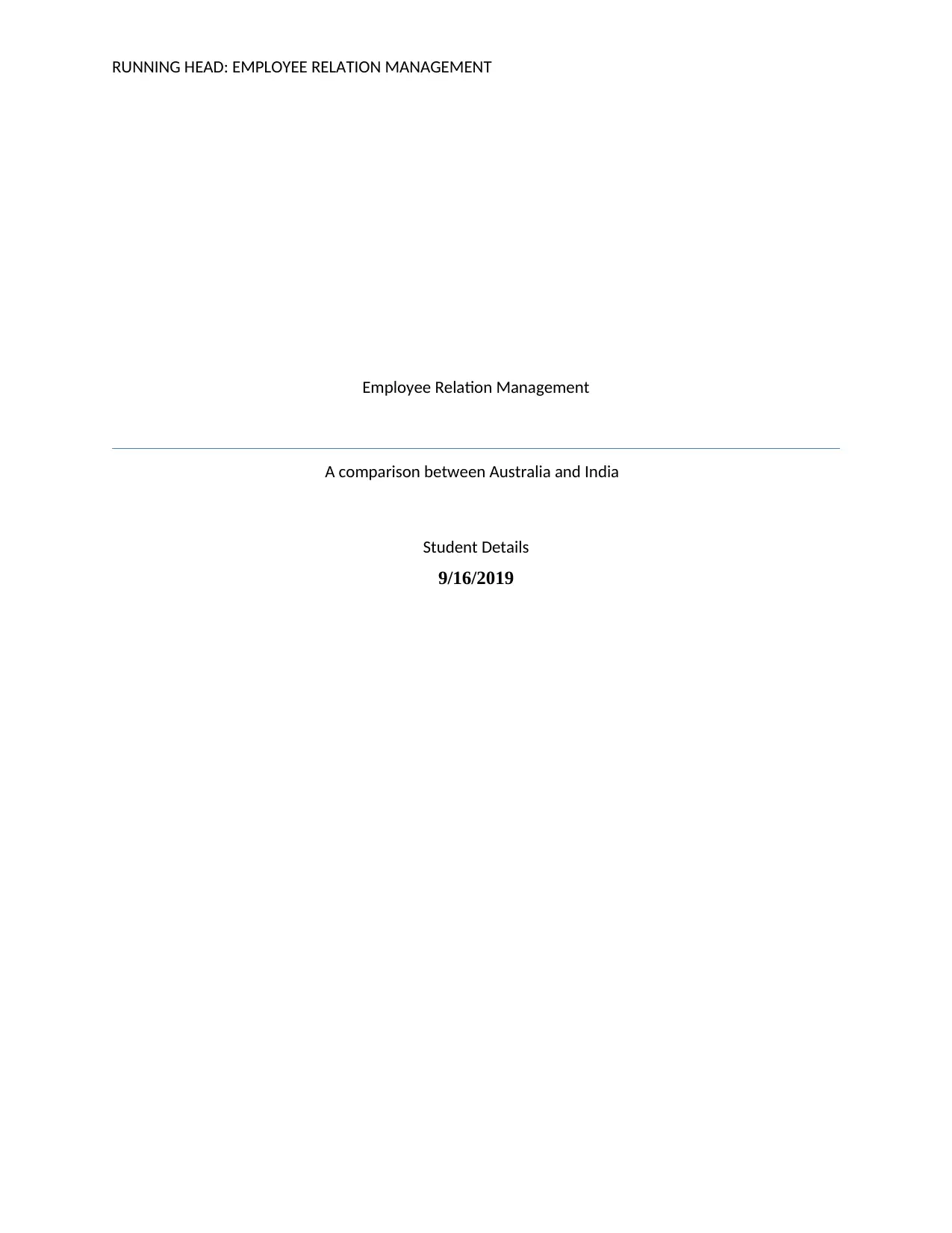
RUNNING HEAD: EMPLOYEE RELATION MANAGEMENT
Employee Relation Management
A comparison between Australia and India
Student Details
9/16/2019
Employee Relation Management
A comparison between Australia and India
Student Details
9/16/2019
Paraphrase This Document
Need a fresh take? Get an instant paraphrase of this document with our AI Paraphraser
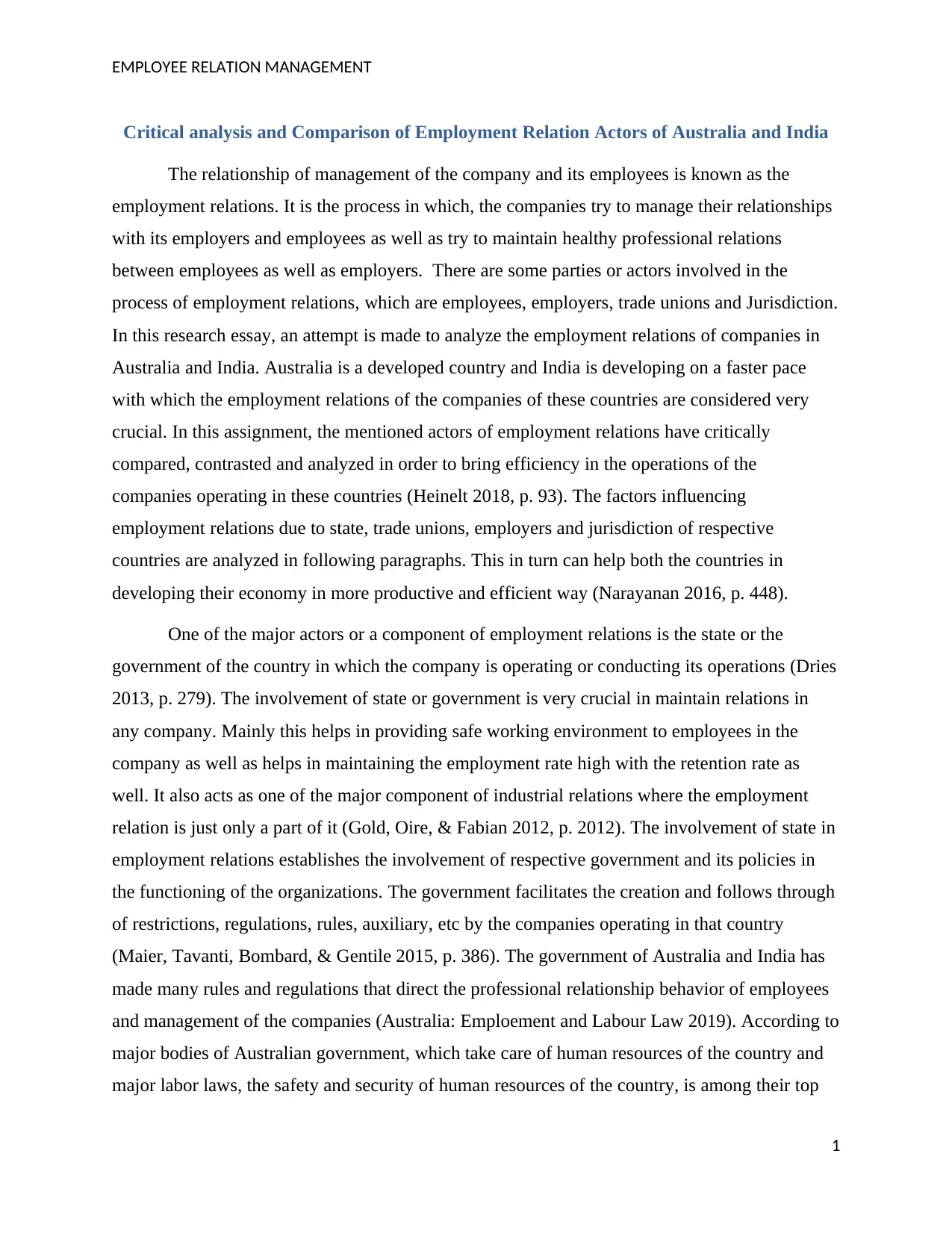
EMPLOYEE RELATION MANAGEMENT
Critical analysis and Comparison of Employment Relation Actors of Australia and India
The relationship of management of the company and its employees is known as the
employment relations. It is the process in which, the companies try to manage their relationships
with its employers and employees as well as try to maintain healthy professional relations
between employees as well as employers. There are some parties or actors involved in the
process of employment relations, which are employees, employers, trade unions and Jurisdiction.
In this research essay, an attempt is made to analyze the employment relations of companies in
Australia and India. Australia is a developed country and India is developing on a faster pace
with which the employment relations of the companies of these countries are considered very
crucial. In this assignment, the mentioned actors of employment relations have critically
compared, contrasted and analyzed in order to bring efficiency in the operations of the
companies operating in these countries (Heinelt 2018, p. 93). The factors influencing
employment relations due to state, trade unions, employers and jurisdiction of respective
countries are analyzed in following paragraphs. This in turn can help both the countries in
developing their economy in more productive and efficient way (Narayanan 2016, p. 448).
One of the major actors or a component of employment relations is the state or the
government of the country in which the company is operating or conducting its operations (Dries
2013, p. 279). The involvement of state or government is very crucial in maintain relations in
any company. Mainly this helps in providing safe working environment to employees in the
company as well as helps in maintaining the employment rate high with the retention rate as
well. It also acts as one of the major component of industrial relations where the employment
relation is just only a part of it (Gold, Oire, & Fabian 2012, p. 2012). The involvement of state in
employment relations establishes the involvement of respective government and its policies in
the functioning of the organizations. The government facilitates the creation and follows through
of restrictions, regulations, rules, auxiliary, etc by the companies operating in that country
(Maier, Tavanti, Bombard, & Gentile 2015, p. 386). The government of Australia and India has
made many rules and regulations that direct the professional relationship behavior of employees
and management of the companies (Australia: Emploement and Labour Law 2019). According to
major bodies of Australian government, which take care of human resources of the country and
major labor laws, the safety and security of human resources of the country, is among their top
1
Critical analysis and Comparison of Employment Relation Actors of Australia and India
The relationship of management of the company and its employees is known as the
employment relations. It is the process in which, the companies try to manage their relationships
with its employers and employees as well as try to maintain healthy professional relations
between employees as well as employers. There are some parties or actors involved in the
process of employment relations, which are employees, employers, trade unions and Jurisdiction.
In this research essay, an attempt is made to analyze the employment relations of companies in
Australia and India. Australia is a developed country and India is developing on a faster pace
with which the employment relations of the companies of these countries are considered very
crucial. In this assignment, the mentioned actors of employment relations have critically
compared, contrasted and analyzed in order to bring efficiency in the operations of the
companies operating in these countries (Heinelt 2018, p. 93). The factors influencing
employment relations due to state, trade unions, employers and jurisdiction of respective
countries are analyzed in following paragraphs. This in turn can help both the countries in
developing their economy in more productive and efficient way (Narayanan 2016, p. 448).
One of the major actors or a component of employment relations is the state or the
government of the country in which the company is operating or conducting its operations (Dries
2013, p. 279). The involvement of state or government is very crucial in maintain relations in
any company. Mainly this helps in providing safe working environment to employees in the
company as well as helps in maintaining the employment rate high with the retention rate as
well. It also acts as one of the major component of industrial relations where the employment
relation is just only a part of it (Gold, Oire, & Fabian 2012, p. 2012). The involvement of state in
employment relations establishes the involvement of respective government and its policies in
the functioning of the organizations. The government facilitates the creation and follows through
of restrictions, regulations, rules, auxiliary, etc by the companies operating in that country
(Maier, Tavanti, Bombard, & Gentile 2015, p. 386). The government of Australia and India has
made many rules and regulations that direct the professional relationship behavior of employees
and management of the companies (Australia: Emploement and Labour Law 2019). According to
major bodies of Australian government, which take care of human resources of the country and
major labor laws, the safety and security of human resources of the country, is among their top
1
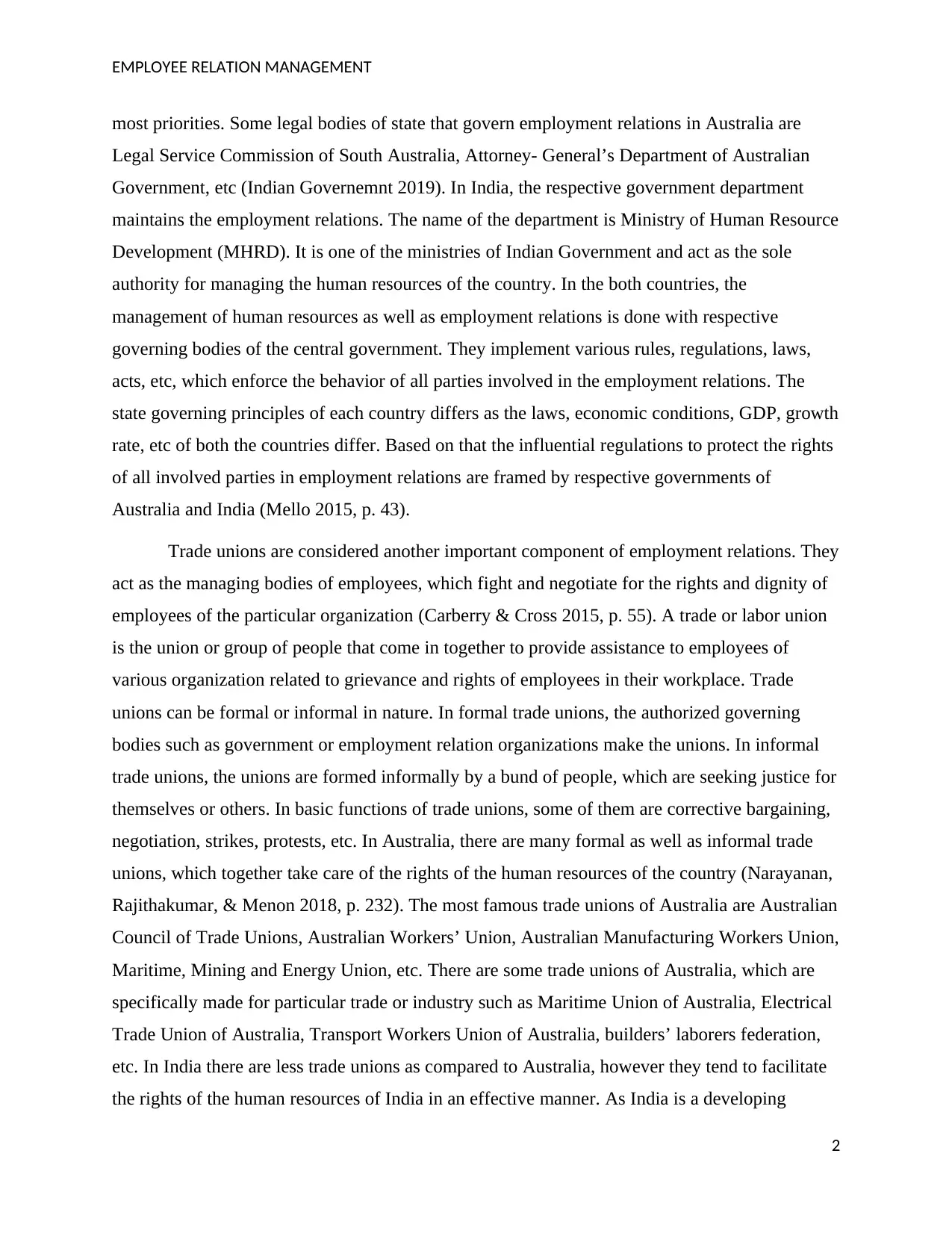
EMPLOYEE RELATION MANAGEMENT
most priorities. Some legal bodies of state that govern employment relations in Australia are
Legal Service Commission of South Australia, Attorney- General’s Department of Australian
Government, etc (Indian Governemnt 2019). In India, the respective government department
maintains the employment relations. The name of the department is Ministry of Human Resource
Development (MHRD). It is one of the ministries of Indian Government and act as the sole
authority for managing the human resources of the country. In the both countries, the
management of human resources as well as employment relations is done with respective
governing bodies of the central government. They implement various rules, regulations, laws,
acts, etc, which enforce the behavior of all parties involved in the employment relations. The
state governing principles of each country differs as the laws, economic conditions, GDP, growth
rate, etc of both the countries differ. Based on that the influential regulations to protect the rights
of all involved parties in employment relations are framed by respective governments of
Australia and India (Mello 2015, p. 43).
Trade unions are considered another important component of employment relations. They
act as the managing bodies of employees, which fight and negotiate for the rights and dignity of
employees of the particular organization (Carberry & Cross 2015, p. 55). A trade or labor union
is the union or group of people that come in together to provide assistance to employees of
various organization related to grievance and rights of employees in their workplace. Trade
unions can be formal or informal in nature. In formal trade unions, the authorized governing
bodies such as government or employment relation organizations make the unions. In informal
trade unions, the unions are formed informally by a bund of people, which are seeking justice for
themselves or others. In basic functions of trade unions, some of them are corrective bargaining,
negotiation, strikes, protests, etc. In Australia, there are many formal as well as informal trade
unions, which together take care of the rights of the human resources of the country (Narayanan,
Rajithakumar, & Menon 2018, p. 232). The most famous trade unions of Australia are Australian
Council of Trade Unions, Australian Workers’ Union, Australian Manufacturing Workers Union,
Maritime, Mining and Energy Union, etc. There are some trade unions of Australia, which are
specifically made for particular trade or industry such as Maritime Union of Australia, Electrical
Trade Union of Australia, Transport Workers Union of Australia, builders’ laborers federation,
etc. In India there are less trade unions as compared to Australia, however they tend to facilitate
the rights of the human resources of India in an effective manner. As India is a developing
2
most priorities. Some legal bodies of state that govern employment relations in Australia are
Legal Service Commission of South Australia, Attorney- General’s Department of Australian
Government, etc (Indian Governemnt 2019). In India, the respective government department
maintains the employment relations. The name of the department is Ministry of Human Resource
Development (MHRD). It is one of the ministries of Indian Government and act as the sole
authority for managing the human resources of the country. In the both countries, the
management of human resources as well as employment relations is done with respective
governing bodies of the central government. They implement various rules, regulations, laws,
acts, etc, which enforce the behavior of all parties involved in the employment relations. The
state governing principles of each country differs as the laws, economic conditions, GDP, growth
rate, etc of both the countries differ. Based on that the influential regulations to protect the rights
of all involved parties in employment relations are framed by respective governments of
Australia and India (Mello 2015, p. 43).
Trade unions are considered another important component of employment relations. They
act as the managing bodies of employees, which fight and negotiate for the rights and dignity of
employees of the particular organization (Carberry & Cross 2015, p. 55). A trade or labor union
is the union or group of people that come in together to provide assistance to employees of
various organization related to grievance and rights of employees in their workplace. Trade
unions can be formal or informal in nature. In formal trade unions, the authorized governing
bodies such as government or employment relation organizations make the unions. In informal
trade unions, the unions are formed informally by a bund of people, which are seeking justice for
themselves or others. In basic functions of trade unions, some of them are corrective bargaining,
negotiation, strikes, protests, etc. In Australia, there are many formal as well as informal trade
unions, which together take care of the rights of the human resources of the country (Narayanan,
Rajithakumar, & Menon 2018, p. 232). The most famous trade unions of Australia are Australian
Council of Trade Unions, Australian Workers’ Union, Australian Manufacturing Workers Union,
Maritime, Mining and Energy Union, etc. There are some trade unions of Australia, which are
specifically made for particular trade or industry such as Maritime Union of Australia, Electrical
Trade Union of Australia, Transport Workers Union of Australia, builders’ laborers federation,
etc. In India there are less trade unions as compared to Australia, however they tend to facilitate
the rights of the human resources of India in an effective manner. As India is a developing
2
⊘ This is a preview!⊘
Do you want full access?
Subscribe today to unlock all pages.

Trusted by 1+ million students worldwide
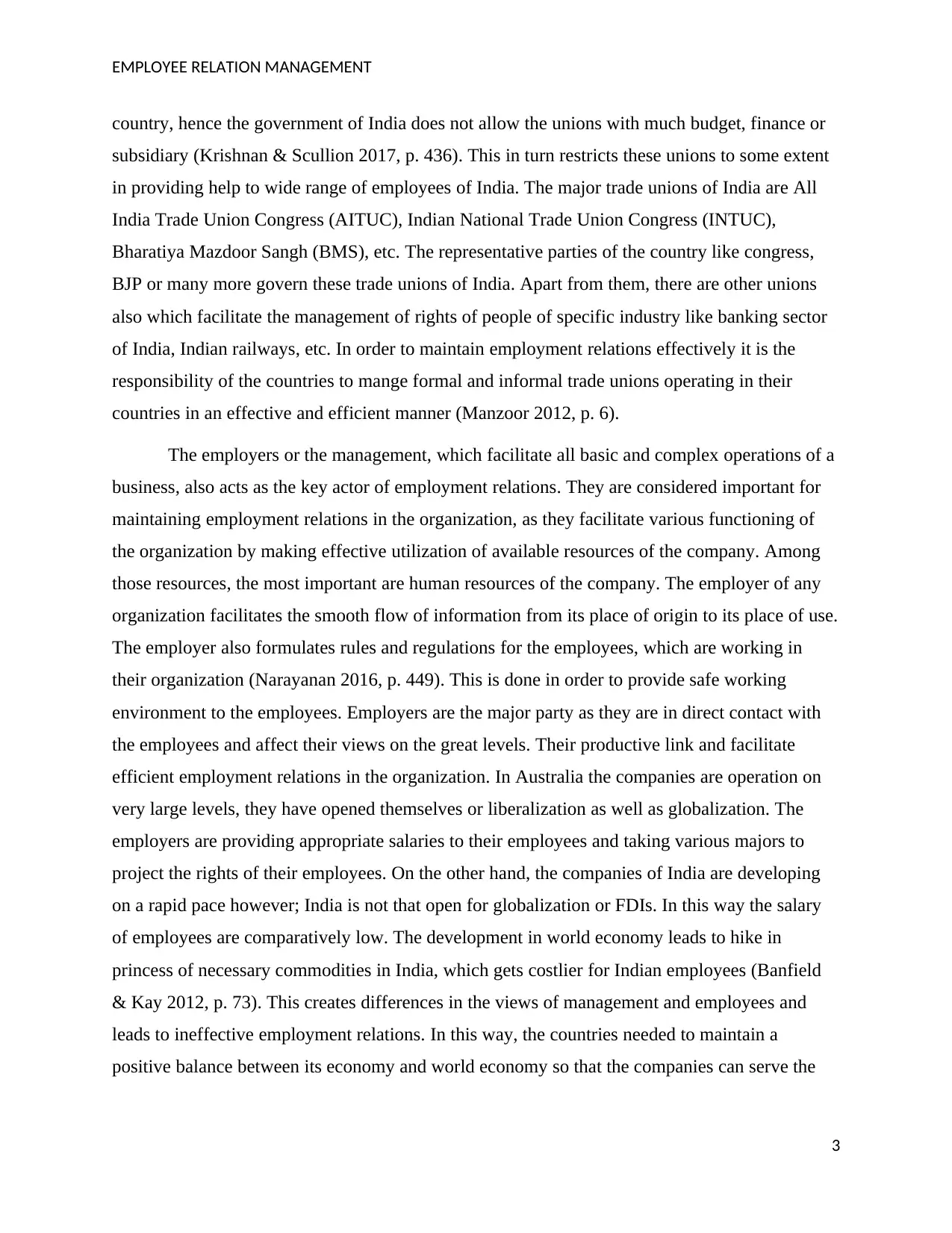
EMPLOYEE RELATION MANAGEMENT
country, hence the government of India does not allow the unions with much budget, finance or
subsidiary (Krishnan & Scullion 2017, p. 436). This in turn restricts these unions to some extent
in providing help to wide range of employees of India. The major trade unions of India are All
India Trade Union Congress (AITUC), Indian National Trade Union Congress (INTUC),
Bharatiya Mazdoor Sangh (BMS), etc. The representative parties of the country like congress,
BJP or many more govern these trade unions of India. Apart from them, there are other unions
also which facilitate the management of rights of people of specific industry like banking sector
of India, Indian railways, etc. In order to maintain employment relations effectively it is the
responsibility of the countries to mange formal and informal trade unions operating in their
countries in an effective and efficient manner (Manzoor 2012, p. 6).
The employers or the management, which facilitate all basic and complex operations of a
business, also acts as the key actor of employment relations. They are considered important for
maintaining employment relations in the organization, as they facilitate various functioning of
the organization by making effective utilization of available resources of the company. Among
those resources, the most important are human resources of the company. The employer of any
organization facilitates the smooth flow of information from its place of origin to its place of use.
The employer also formulates rules and regulations for the employees, which are working in
their organization (Narayanan 2016, p. 449). This is done in order to provide safe working
environment to the employees. Employers are the major party as they are in direct contact with
the employees and affect their views on the great levels. Their productive link and facilitate
efficient employment relations in the organization. In Australia the companies are operation on
very large levels, they have opened themselves or liberalization as well as globalization. The
employers are providing appropriate salaries to their employees and taking various majors to
project the rights of their employees. On the other hand, the companies of India are developing
on a rapid pace however; India is not that open for globalization or FDIs. In this way the salary
of employees are comparatively low. The development in world economy leads to hike in
princess of necessary commodities in India, which gets costlier for Indian employees (Banfield
& Kay 2012, p. 73). This creates differences in the views of management and employees and
leads to ineffective employment relations. In this way, the countries needed to maintain a
positive balance between its economy and world economy so that the companies can serve the
3
country, hence the government of India does not allow the unions with much budget, finance or
subsidiary (Krishnan & Scullion 2017, p. 436). This in turn restricts these unions to some extent
in providing help to wide range of employees of India. The major trade unions of India are All
India Trade Union Congress (AITUC), Indian National Trade Union Congress (INTUC),
Bharatiya Mazdoor Sangh (BMS), etc. The representative parties of the country like congress,
BJP or many more govern these trade unions of India. Apart from them, there are other unions
also which facilitate the management of rights of people of specific industry like banking sector
of India, Indian railways, etc. In order to maintain employment relations effectively it is the
responsibility of the countries to mange formal and informal trade unions operating in their
countries in an effective and efficient manner (Manzoor 2012, p. 6).
The employers or the management, which facilitate all basic and complex operations of a
business, also acts as the key actor of employment relations. They are considered important for
maintaining employment relations in the organization, as they facilitate various functioning of
the organization by making effective utilization of available resources of the company. Among
those resources, the most important are human resources of the company. The employer of any
organization facilitates the smooth flow of information from its place of origin to its place of use.
The employer also formulates rules and regulations for the employees, which are working in
their organization (Narayanan 2016, p. 449). This is done in order to provide safe working
environment to the employees. Employers are the major party as they are in direct contact with
the employees and affect their views on the great levels. Their productive link and facilitate
efficient employment relations in the organization. In Australia the companies are operation on
very large levels, they have opened themselves or liberalization as well as globalization. The
employers are providing appropriate salaries to their employees and taking various majors to
project the rights of their employees. On the other hand, the companies of India are developing
on a rapid pace however; India is not that open for globalization or FDIs. In this way the salary
of employees are comparatively low. The development in world economy leads to hike in
princess of necessary commodities in India, which gets costlier for Indian employees (Banfield
& Kay 2012, p. 73). This creates differences in the views of management and employees and
leads to ineffective employment relations. In this way, the countries needed to maintain a
positive balance between its economy and world economy so that the companies can serve the
3
Paraphrase This Document
Need a fresh take? Get an instant paraphrase of this document with our AI Paraphraser
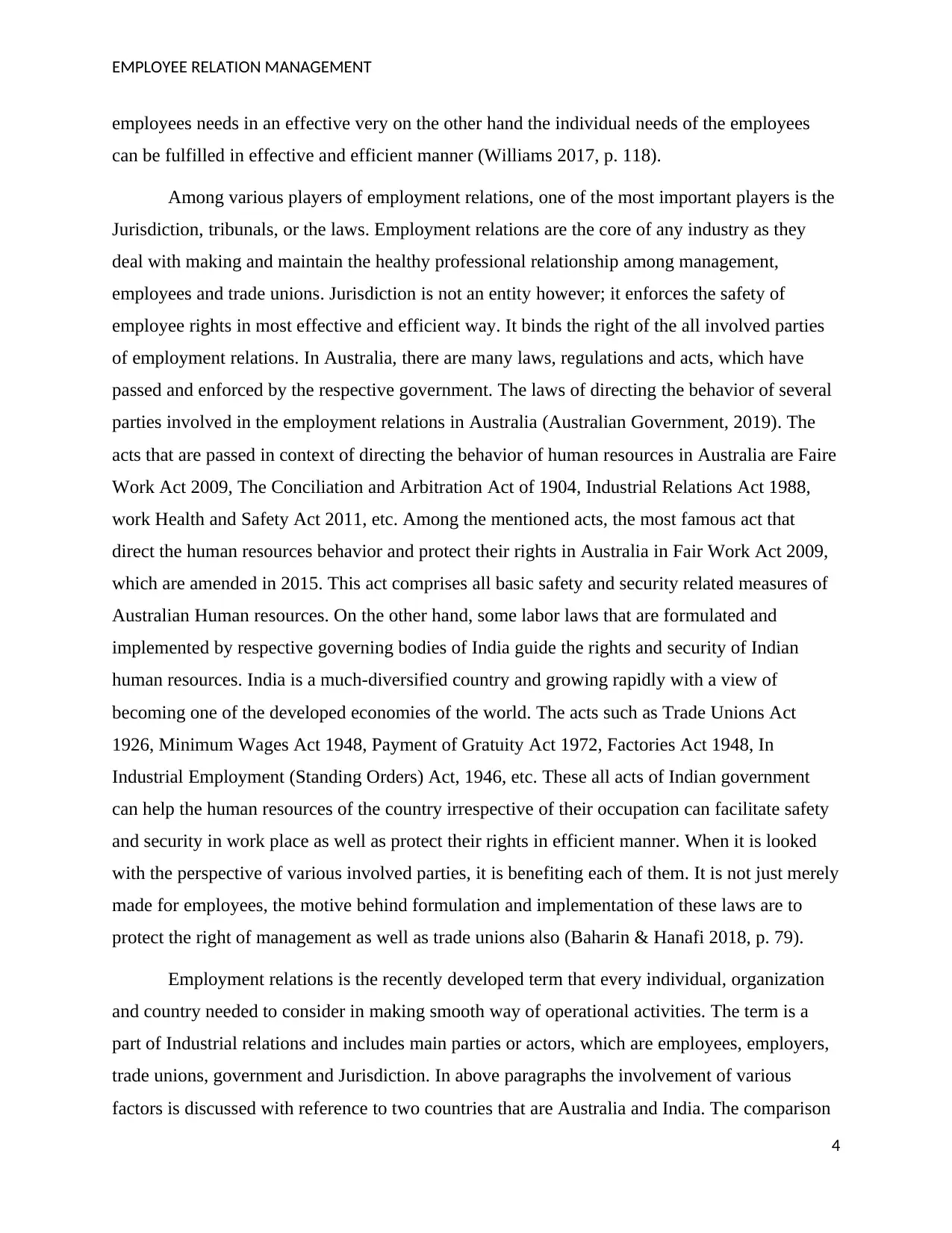
EMPLOYEE RELATION MANAGEMENT
employees needs in an effective very on the other hand the individual needs of the employees
can be fulfilled in effective and efficient manner (Williams 2017, p. 118).
Among various players of employment relations, one of the most important players is the
Jurisdiction, tribunals, or the laws. Employment relations are the core of any industry as they
deal with making and maintain the healthy professional relationship among management,
employees and trade unions. Jurisdiction is not an entity however; it enforces the safety of
employee rights in most effective and efficient way. It binds the right of the all involved parties
of employment relations. In Australia, there are many laws, regulations and acts, which have
passed and enforced by the respective government. The laws of directing the behavior of several
parties involved in the employment relations in Australia (Australian Government, 2019). The
acts that are passed in context of directing the behavior of human resources in Australia are Faire
Work Act 2009, The Conciliation and Arbitration Act of 1904, Industrial Relations Act 1988,
work Health and Safety Act 2011, etc. Among the mentioned acts, the most famous act that
direct the human resources behavior and protect their rights in Australia in Fair Work Act 2009,
which are amended in 2015. This act comprises all basic safety and security related measures of
Australian Human resources. On the other hand, some labor laws that are formulated and
implemented by respective governing bodies of India guide the rights and security of Indian
human resources. India is a much-diversified country and growing rapidly with a view of
becoming one of the developed economies of the world. The acts such as Trade Unions Act
1926, Minimum Wages Act 1948, Payment of Gratuity Act 1972, Factories Act 1948, In
Industrial Employment (Standing Orders) Act, 1946, etc. These all acts of Indian government
can help the human resources of the country irrespective of their occupation can facilitate safety
and security in work place as well as protect their rights in efficient manner. When it is looked
with the perspective of various involved parties, it is benefiting each of them. It is not just merely
made for employees, the motive behind formulation and implementation of these laws are to
protect the right of management as well as trade unions also (Baharin & Hanafi 2018, p. 79).
Employment relations is the recently developed term that every individual, organization
and country needed to consider in making smooth way of operational activities. The term is a
part of Industrial relations and includes main parties or actors, which are employees, employers,
trade unions, government and Jurisdiction. In above paragraphs the involvement of various
factors is discussed with reference to two countries that are Australia and India. The comparison
4
employees needs in an effective very on the other hand the individual needs of the employees
can be fulfilled in effective and efficient manner (Williams 2017, p. 118).
Among various players of employment relations, one of the most important players is the
Jurisdiction, tribunals, or the laws. Employment relations are the core of any industry as they
deal with making and maintain the healthy professional relationship among management,
employees and trade unions. Jurisdiction is not an entity however; it enforces the safety of
employee rights in most effective and efficient way. It binds the right of the all involved parties
of employment relations. In Australia, there are many laws, regulations and acts, which have
passed and enforced by the respective government. The laws of directing the behavior of several
parties involved in the employment relations in Australia (Australian Government, 2019). The
acts that are passed in context of directing the behavior of human resources in Australia are Faire
Work Act 2009, The Conciliation and Arbitration Act of 1904, Industrial Relations Act 1988,
work Health and Safety Act 2011, etc. Among the mentioned acts, the most famous act that
direct the human resources behavior and protect their rights in Australia in Fair Work Act 2009,
which are amended in 2015. This act comprises all basic safety and security related measures of
Australian Human resources. On the other hand, some labor laws that are formulated and
implemented by respective governing bodies of India guide the rights and security of Indian
human resources. India is a much-diversified country and growing rapidly with a view of
becoming one of the developed economies of the world. The acts such as Trade Unions Act
1926, Minimum Wages Act 1948, Payment of Gratuity Act 1972, Factories Act 1948, In
Industrial Employment (Standing Orders) Act, 1946, etc. These all acts of Indian government
can help the human resources of the country irrespective of their occupation can facilitate safety
and security in work place as well as protect their rights in efficient manner. When it is looked
with the perspective of various involved parties, it is benefiting each of them. It is not just merely
made for employees, the motive behind formulation and implementation of these laws are to
protect the right of management as well as trade unions also (Baharin & Hanafi 2018, p. 79).
Employment relations is the recently developed term that every individual, organization
and country needed to consider in making smooth way of operational activities. The term is a
part of Industrial relations and includes main parties or actors, which are employees, employers,
trade unions, government and Jurisdiction. In above paragraphs the involvement of various
factors is discussed with reference to two countries that are Australia and India. The comparison
4
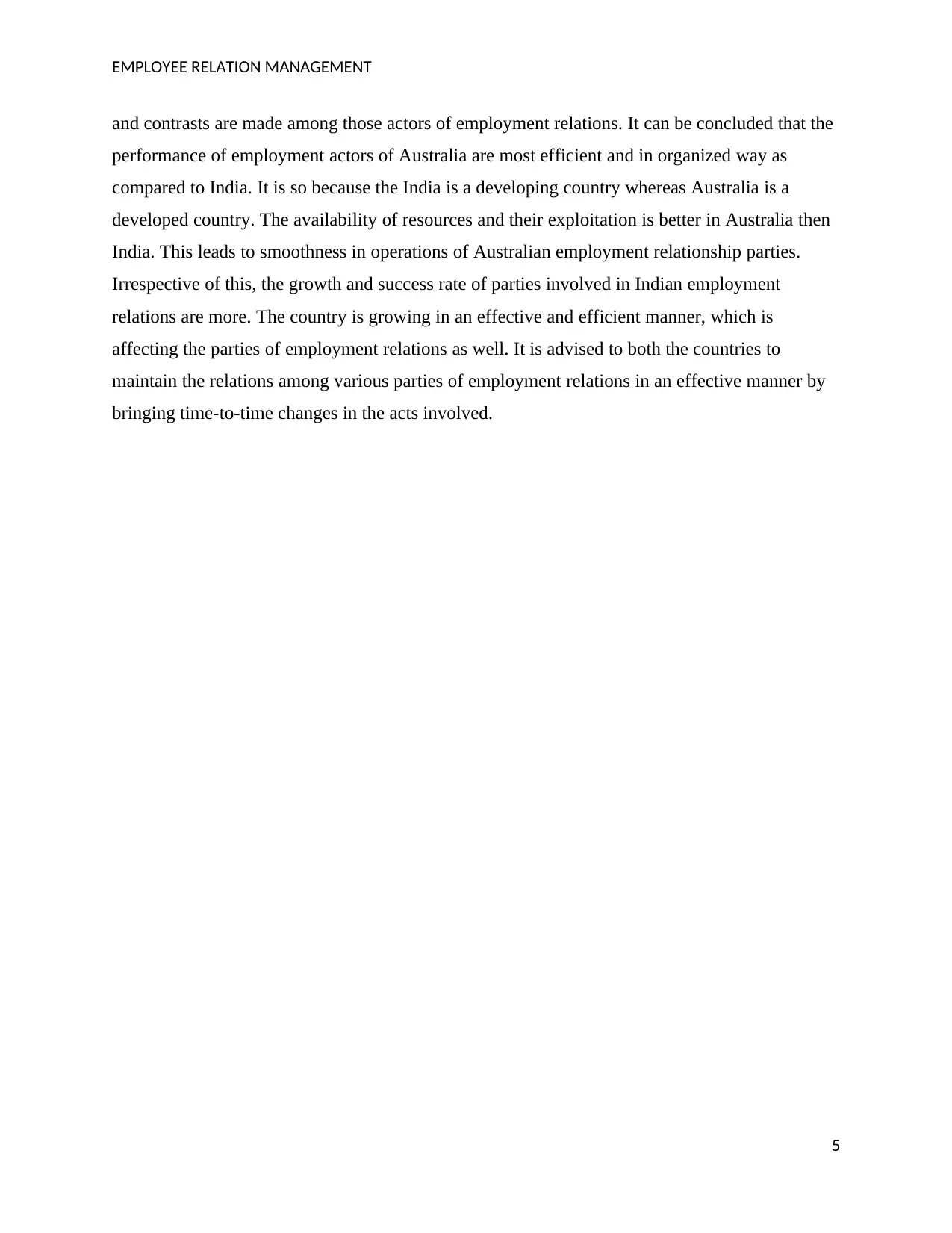
EMPLOYEE RELATION MANAGEMENT
and contrasts are made among those actors of employment relations. It can be concluded that the
performance of employment actors of Australia are most efficient and in organized way as
compared to India. It is so because the India is a developing country whereas Australia is a
developed country. The availability of resources and their exploitation is better in Australia then
India. This leads to smoothness in operations of Australian employment relationship parties.
Irrespective of this, the growth and success rate of parties involved in Indian employment
relations are more. The country is growing in an effective and efficient manner, which is
affecting the parties of employment relations as well. It is advised to both the countries to
maintain the relations among various parties of employment relations in an effective manner by
bringing time-to-time changes in the acts involved.
5
and contrasts are made among those actors of employment relations. It can be concluded that the
performance of employment actors of Australia are most efficient and in organized way as
compared to India. It is so because the India is a developing country whereas Australia is a
developed country. The availability of resources and their exploitation is better in Australia then
India. This leads to smoothness in operations of Australian employment relationship parties.
Irrespective of this, the growth and success rate of parties involved in Indian employment
relations are more. The country is growing in an effective and efficient manner, which is
affecting the parties of employment relations as well. It is advised to both the countries to
maintain the relations among various parties of employment relations in an effective manner by
bringing time-to-time changes in the acts involved.
5
⊘ This is a preview!⊘
Do you want full access?
Subscribe today to unlock all pages.

Trusted by 1+ million students worldwide
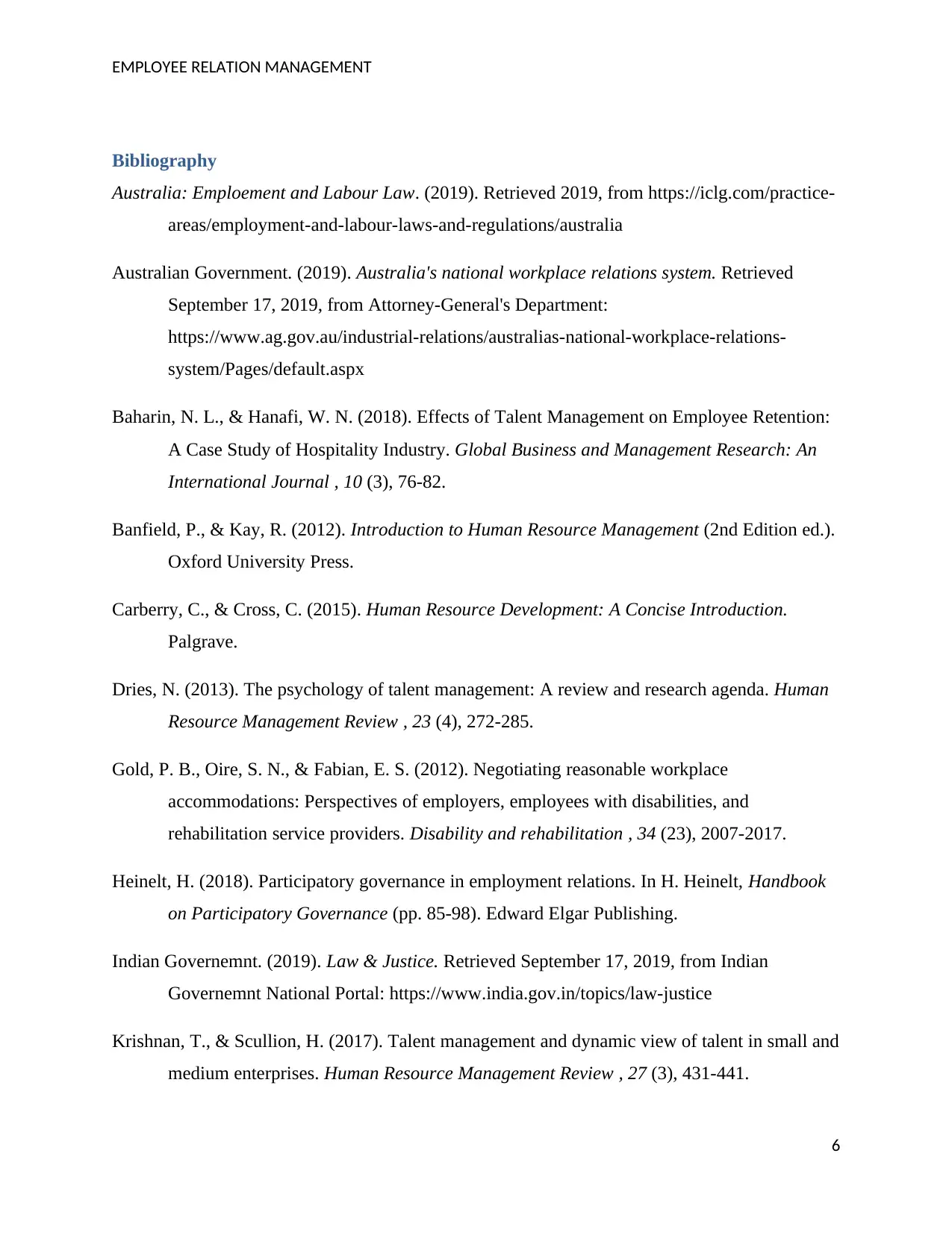
EMPLOYEE RELATION MANAGEMENT
Bibliography
Australia: Emploement and Labour Law. (2019). Retrieved 2019, from https://iclg.com/practice-
areas/employment-and-labour-laws-and-regulations/australia
Australian Government. (2019). Australia's national workplace relations system. Retrieved
September 17, 2019, from Attorney-General's Department:
https://www.ag.gov.au/industrial-relations/australias-national-workplace-relations-
system/Pages/default.aspx
Baharin, N. L., & Hanafi, W. N. (2018). Effects of Talent Management on Employee Retention:
A Case Study of Hospitality Industry. Global Business and Management Research: An
International Journal , 10 (3), 76-82.
Banfield, P., & Kay, R. (2012). Introduction to Human Resource Management (2nd Edition ed.).
Oxford University Press.
Carberry, C., & Cross, C. (2015). Human Resource Development: A Concise Introduction.
Palgrave.
Dries, N. (2013). The psychology of talent management: A review and research agenda. Human
Resource Management Review , 23 (4), 272-285.
Gold, P. B., Oire, S. N., & Fabian, E. S. (2012). Negotiating reasonable workplace
accommodations: Perspectives of employers, employees with disabilities, and
rehabilitation service providers. Disability and rehabilitation , 34 (23), 2007-2017.
Heinelt, H. (2018). Participatory governance in employment relations. In H. Heinelt, Handbook
on Participatory Governance (pp. 85-98). Edward Elgar Publishing.
Indian Governemnt. (2019). Law & Justice. Retrieved September 17, 2019, from Indian
Governemnt National Portal: https://www.india.gov.in/topics/law-justice
Krishnan, T., & Scullion, H. (2017). Talent management and dynamic view of talent in small and
medium enterprises. Human Resource Management Review , 27 (3), 431-441.
6
Bibliography
Australia: Emploement and Labour Law. (2019). Retrieved 2019, from https://iclg.com/practice-
areas/employment-and-labour-laws-and-regulations/australia
Australian Government. (2019). Australia's national workplace relations system. Retrieved
September 17, 2019, from Attorney-General's Department:
https://www.ag.gov.au/industrial-relations/australias-national-workplace-relations-
system/Pages/default.aspx
Baharin, N. L., & Hanafi, W. N. (2018). Effects of Talent Management on Employee Retention:
A Case Study of Hospitality Industry. Global Business and Management Research: An
International Journal , 10 (3), 76-82.
Banfield, P., & Kay, R. (2012). Introduction to Human Resource Management (2nd Edition ed.).
Oxford University Press.
Carberry, C., & Cross, C. (2015). Human Resource Development: A Concise Introduction.
Palgrave.
Dries, N. (2013). The psychology of talent management: A review and research agenda. Human
Resource Management Review , 23 (4), 272-285.
Gold, P. B., Oire, S. N., & Fabian, E. S. (2012). Negotiating reasonable workplace
accommodations: Perspectives of employers, employees with disabilities, and
rehabilitation service providers. Disability and rehabilitation , 34 (23), 2007-2017.
Heinelt, H. (2018). Participatory governance in employment relations. In H. Heinelt, Handbook
on Participatory Governance (pp. 85-98). Edward Elgar Publishing.
Indian Governemnt. (2019). Law & Justice. Retrieved September 17, 2019, from Indian
Governemnt National Portal: https://www.india.gov.in/topics/law-justice
Krishnan, T., & Scullion, H. (2017). Talent management and dynamic view of talent in small and
medium enterprises. Human Resource Management Review , 27 (3), 431-441.
6
Paraphrase This Document
Need a fresh take? Get an instant paraphrase of this document with our AI Paraphraser
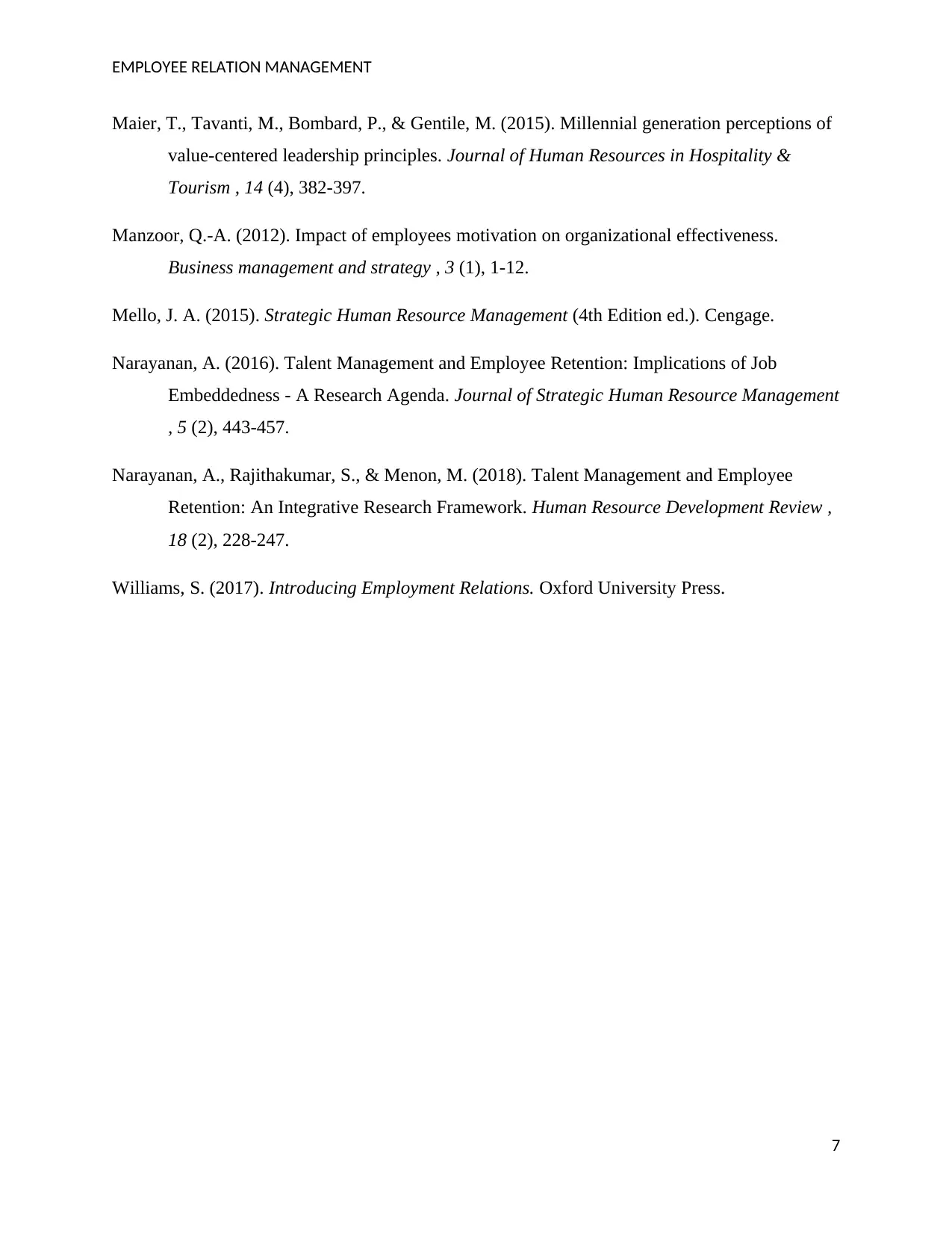
EMPLOYEE RELATION MANAGEMENT
Maier, T., Tavanti, M., Bombard, P., & Gentile, M. (2015). Millennial generation perceptions of
value-centered leadership principles. Journal of Human Resources in Hospitality &
Tourism , 14 (4), 382-397.
Manzoor, Q.-A. (2012). Impact of employees motivation on organizational effectiveness.
Business management and strategy , 3 (1), 1-12.
Mello, J. A. (2015). Strategic Human Resource Management (4th Edition ed.). Cengage.
Narayanan, A. (2016). Talent Management and Employee Retention: Implications of Job
Embeddedness - A Research Agenda. Journal of Strategic Human Resource Management
, 5 (2), 443-457.
Narayanan, A., Rajithakumar, S., & Menon, M. (2018). Talent Management and Employee
Retention: An Integrative Research Framework. Human Resource Development Review ,
18 (2), 228-247.
Williams, S. (2017). Introducing Employment Relations. Oxford University Press.
7
Maier, T., Tavanti, M., Bombard, P., & Gentile, M. (2015). Millennial generation perceptions of
value-centered leadership principles. Journal of Human Resources in Hospitality &
Tourism , 14 (4), 382-397.
Manzoor, Q.-A. (2012). Impact of employees motivation on organizational effectiveness.
Business management and strategy , 3 (1), 1-12.
Mello, J. A. (2015). Strategic Human Resource Management (4th Edition ed.). Cengage.
Narayanan, A. (2016). Talent Management and Employee Retention: Implications of Job
Embeddedness - A Research Agenda. Journal of Strategic Human Resource Management
, 5 (2), 443-457.
Narayanan, A., Rajithakumar, S., & Menon, M. (2018). Talent Management and Employee
Retention: An Integrative Research Framework. Human Resource Development Review ,
18 (2), 228-247.
Williams, S. (2017). Introducing Employment Relations. Oxford University Press.
7
1 out of 8
Related Documents
Your All-in-One AI-Powered Toolkit for Academic Success.
+13062052269
info@desklib.com
Available 24*7 on WhatsApp / Email
![[object Object]](/_next/static/media/star-bottom.7253800d.svg)
Unlock your academic potential
Copyright © 2020–2025 A2Z Services. All Rights Reserved. Developed and managed by ZUCOL.





